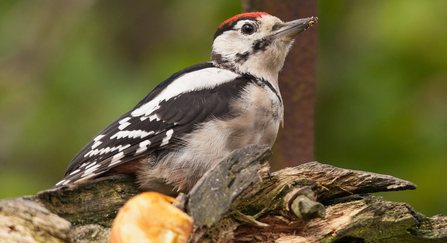
Greater Spotted Woodpecker, WildNet - Bob Coyle
Chris Lawrence

Greater Spotted Woodpecker, WildNet - Bob Coyle
The most obvious wildlife is probably the birds, the coast can be very rewarding this time of year with multitudes of ducks and waders, however restrictions are likely to put this out of range for most at present. Thankfully our gardens and local parks can be great areas for close views of finches, tits, thrushes and maybe even a woodpecker or Nuthatch. All this activity will often attract the attention of the local Sparrow-hawk, adding true drama and excitement. If you can feed the birds it will help them greatly during the cold weather and also afford you fantastic views from the warmth and safety of home.
Another great place to find winter birds locally is a local lake or reservoir. They are a magnet for waterfowl, even those within urban parks can hold a good variety of species. Amongst the ubiquitous Mallards, graceful Swans and tamer escapes that eagerly take food from the children, there can be Tufted Ducks, Moorhens, Coots, a selection of gulls, maybe a Great Crested Grebe, and if you are lucky a Kingfisher may flash by.
Many of us should be within walking distance of a woodland, they can sometimes seem quite lifeless places at this time of year, however even as the trees slumber there are signs of spring:
Now is a great time to appreciate the elegant fronds of ferns as many of them persist over winter and the tufts can be more clearly seen scattered as green sentinels amongst the dead leaf litter. Many look quite similar but with an inquisitive eye and a bit of practice a number of different species can be found.
New leaves will be pushing up through the cold, damp soil and as January moves in to February the first flowers will bloom. Look out for the yellow buttercup like flowers of Lesser Celandine beginning to spangle the woodland floor and the purple/white flowers of Sweet Violet together with its fragrant scent. They are the only native violet species with a scent, interestingly, there is a legend that you can only smell a Sweet Violet once in your life, this isn’t true, however there is some truth to it as one of the chemicals in its scent is Ionine which deadens your smell receptors for a while.
Whilst in the woods, also look out for the distinctive Scarlet Elf Cup. We tend to think of autumn being the time for fungi, however the Scarlet Elf Cup appears as a late winter precursor to spring, sprouting out of rotting branches on the woodland floor. It is said in folklore that elves drank morning dew from the “cups”.
Keep your ears as well as your eyes open as some of the birds will be warming up their voices, auditioning for the forthcoming spring dawn chorus. The Mistle Thrush is well known for singing early in the year and during the foulest weather, earning it the colloquial name of Storm-cock. In fact, some of our birds will be starting to construct nests already, the nests of Rooks should be very visible in the skeletal trees before springs cloth hides them away and Tawny Owls will be well underway with breeding in February, listen for their twits and hoots at night.
Hopefully, seeking out all this wildlife I've mentioned will keep your spirits up until spring when the flowers will bloom, insects will appear, hibernating animals will emerge from their slumber ahead of the summer migrants arriving, and with this we also emerge from lockdown.
In the meantime, why not join me on our Facebook page for our Winter Wildlife Wednesday question time, where for one hour between 12 midday and 1pm every Weds in Jan, I'll be online to answer all your local winter wildlife queries and conundrums.
Photo by Rob Magee
Join me, Andy Karran between 12 midday and 1pm for our GWT Winter Wildlife Wednesday question time on our Facebook page.